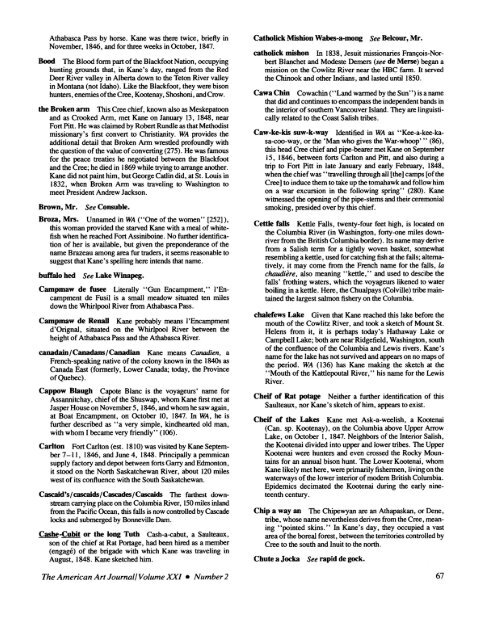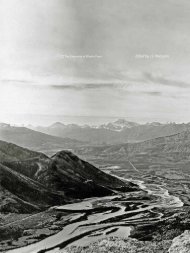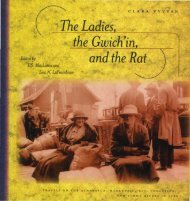Paul Kane's Journal of his Western Travels, 1846-1848 - History and ...
Paul Kane's Journal of his Western Travels, 1846-1848 - History and ...
Paul Kane's Journal of his Western Travels, 1846-1848 - History and ...
Create successful ePaper yourself
Turn your PDF publications into a flip-book with our unique Google optimized e-Paper software.
Athabasca Pass by horse. Kane was there twice, briefly in<br />
November, <strong>1846</strong>, <strong>and</strong> for three weeks in October, 1847.<br />
Hood The Blood fonn part <strong>of</strong> the Blackfoot Nation, occupying<br />
hunting grounds that, in <strong>Kane's</strong> day, ranged from the Red<br />
Deer River valley in Alberta down to the Teton River valley<br />
in Montana (not Idaho). Like the Blackfoot, they were bison<br />
hunters, enemies <strong>of</strong> the Cree, Kootenay, Shoshoni, <strong>and</strong> Crow.<br />
the Broken ann T<strong>his</strong> Cree chief, known also as Meskepatoon<br />
<strong>and</strong> as Crooked Ann, met Kane on January 13, <strong>1848</strong>, near<br />
Fort Pitt. He was claimed by Robert Rundle as that Methodist<br />
missionary's first convert to Christianity. WA provides the<br />
additional detail that Broken Ann wrestled pr<strong>of</strong>oundly with<br />
the question <strong>of</strong> the value <strong>of</strong> converting (275). He was famous<br />
for the peace treaties he negotiated between the Blackfoot<br />
<strong>and</strong> the Cree; he died in 1869 while trying to arrange another.<br />
Kane did not paint him, but George Catlin did, at St. Louis in<br />
1832, when Broken Ann was traveling to Washington to<br />
meet President Andrew Jackson.<br />
Brown, Mr. See Consuble.<br />
Broza, Mrs. Unnamed in WA ("One <strong>of</strong> the women" [252]),<br />
t<strong>his</strong> woman provided the starved Kane with a meal <strong>of</strong> whitefish<br />
when he reached Fort Assiniboine. No further identification<br />
<strong>of</strong> her is available, but given the preponderance <strong>of</strong> the<br />
name Brazeau among area fur traders, it seems reasonable to<br />
suggest that <strong>Kane's</strong> spelling here intends that name.<br />
buffalo hed See Lake Winapeg.<br />
Campmaw de fusee Literally "Gun Encampment," I'Encampment<br />
de Fusil is a small meadow situated ten miles<br />
down the Whirlpool River from Athabasca Pass.<br />
Campmaw de Kenan Kane probably means I 'Encampment<br />
d'Orignal, situated on the Whirlpool River between the<br />
height <strong>of</strong> Athabasca Pass <strong>and</strong> the Athabasca River.<br />
canadain/Canadans/Canadian Kane means Canadien, a<br />
French-speaking native <strong>of</strong> the colony known in the 1840s as<br />
Canada East (fonnerly, Lower Canada; today, the Province<br />
<strong>of</strong> Quebec).<br />
Cappow Blaugh Capote Blanc is the voyageurs' name for<br />
Assannitchay, chief <strong>of</strong> the Shuswap, whom Kane first met at<br />
Jasper House on November 5, <strong>1846</strong>, <strong>and</strong> whom he saw again,<br />
at Boat Encampment, on October 10, 1847. In WA, he is<br />
further described as "a very simple, kindhearted old man,<br />
with whom I became very friendly" (106).<br />
Carlton Fort Carlton (est. 1810) was visited by Kane September<br />
7-11, <strong>1846</strong>, <strong>and</strong> June 4, <strong>1848</strong>. Principally a pemmican<br />
supply factory <strong>and</strong> depot between forts Garry <strong>and</strong> Edmonton,<br />
it stood on the North Saskatchewan River, about 120 miles<br />
west <strong>of</strong> its confluence with the South Saskatchewan.<br />
C~d's/CB:aids/C~des/C~ds The farthest downstream<br />
carrying place on the Columbia River, 150 miles inl<strong>and</strong><br />
from the Pacific Ocean, t<strong>his</strong> falls is now controlled by Cascade<br />
locks <strong>and</strong> submerged by Bonneville Dam.<br />
Cashe-Cubit or the long Tutb Cash-a-cabut, a Saulteaux,<br />
son <strong>of</strong> the chief at Rat Ponage, had been hired as a member<br />
(engage) <strong>of</strong> the brigade with which Kane was traveling in<br />
August, <strong>1848</strong>. Kane sketched him.<br />
The American Art <strong>Journal</strong>/Volume XXI • Number 2<br />
Catholick Mishion Wabes-a-mong See Belcour, Mr.<br />
catholick mishon In 1838, Jesuit missionaries Fran~ois-Norbert<br />
Blanchet <strong>and</strong> Modeste Demers (see de Merse) began a<br />
mission on the Cowlitz River near the HBC fann. It served<br />
the Chinook <strong>and</strong> other Indians, <strong>and</strong> lasted until 1850.<br />
Cawa Chin Cowachin ("L<strong>and</strong> wanned by the Sun") is a name<br />
that did <strong>and</strong> continues to encompass the independent b<strong>and</strong>s in<br />
the interior <strong>of</strong> southern Vancouver Isl<strong>and</strong>. They are linguistically<br />
related to the Coast Salish tribes.<br />
Caw-ke-kis suw-k-way Identified in WA as "Kee-a-kee-kasa-coo-way,<br />
or the 'Man who gives the War-whoop'" (86),<br />
t<strong>his</strong> head Cree chief <strong>and</strong> pipe-bearer met Kane on September<br />
15, <strong>1846</strong>, between forts Carlton <strong>and</strong> Pitt, <strong>and</strong> also during a<br />
trip to Fort Pitt in late January <strong>and</strong> early February, <strong>1848</strong>,<br />
when the chief was "travelling through all [the] camps [<strong>of</strong> the<br />
Cree] to induce them to take up the tomahawk <strong>and</strong> follow him<br />
on a war excursion in the following spring" (280). Kane<br />
witnessed the opening <strong>of</strong> the pipe-stems <strong>and</strong> their ceremonial<br />
smoking, presided over by t<strong>his</strong> chief.<br />
Cettle falls Kettle Falls, twenty-four feet high, is located on<br />
the Columbia River (in Washington, forty-one miles downriver<br />
from the British Columbia border). Its name may derive<br />
from a Salish tenn for a tightly woven basket, somewhat<br />
resembling a kettle, used for catching fish at the falls; alternatively,<br />
it may come from the French name for the falls, La<br />
chaudiere, also meaning "kettle," <strong>and</strong> used to descibe the<br />
falls' frothing waters, which the voyageurs likened to water<br />
boiling in a kettle. Here, the Chualpays (Colville) tribe maintained<br />
the largest salmon fishery on the Columbia.<br />
cbalefews Lake Given that Kane reached t<strong>his</strong> lake before the<br />
mouth <strong>of</strong> the Cowlitz River, <strong>and</strong> took a sketch <strong>of</strong> Mount St.<br />
Helens from it, it is perhaps today's Hathaway Lake or<br />
Campbell Lake; both are near Ridgefield, Washington, south<br />
<strong>of</strong> the confluence <strong>of</strong> the Columbia <strong>and</strong> Lewis rivers. <strong>Kane's</strong><br />
name for the lake has not survived <strong>and</strong> appears on no maps <strong>of</strong><br />
the period. WA (136) has Kane making the sketch at the<br />
, 'Mouth <strong>of</strong> the Kattlepoutal River," <strong>his</strong> name for the Lewis<br />
River.<br />
Cheif <strong>of</strong> Rat potage Neither a further identification <strong>of</strong> t<strong>his</strong><br />
Saulteaux, nor <strong>Kane's</strong> sketch <strong>of</strong> him, appears to exist.<br />
Cheif <strong>of</strong> the Lakes Kane met Ask-a-weelish, a Kootenai<br />
(Can. sp. Kootenay), on the Columbia above Upper Arrow<br />
Lake, on October I, 1847. Neighbors <strong>of</strong> the Interior Salish,<br />
the Kootenai divided into upper <strong>and</strong> lower tribes. The Upper<br />
Kootenai were hunters <strong>and</strong> even crossed the Rocky Mountains<br />
for an annual bison hunt. The Lower Kootenai, whom<br />
Kane likely met here, were primarily fishermen, living on the<br />
waterways <strong>of</strong> the lower interior <strong>of</strong> modem British Columbia.<br />
Epidemics decimated the Kootenai during the early nineteenth<br />
century .<br />
Chip a wayan The Chipewyan are an Athapaskan, or Dene,<br />
tribe, whose name nevertheless derives from the Cree, meaning<br />
"pointed skins." In <strong>Kane's</strong> day, they occupied a vast<br />
area <strong>of</strong> the boreal forest, between the territories controlled by<br />
Cree to the south <strong>and</strong> Inuit to the north.<br />
Chute a Jocka See rapid de gock.<br />
67
















